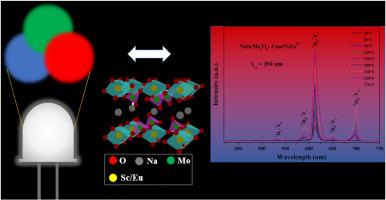下转换NaScMo2O8:Eu3+荧光粉用于白光led的热增强发光
IF 3.5
3区 化学
Q2 CHEMISTRY, INORGANIC & NUCLEAR
引用次数: 0
摘要
荧光粉的热猝灭效应严重限制了发光材料在高温环境中的应用,可能导致器件性能下降甚至系统失效。目前,缺乏具有高发光效率,优异稳定性和高色纯度的红色荧光粉,使其适合白色发光二极管(led)。本文通过合成Eu3+掺杂的单斜斜NaScMo2O8荧光粉,实现了在高温下增强发光的策略,并通过XRD, SEM, TG和PL光谱对其结构,形态,热学和光学性质进行了表征。光学性质的综合研究表明,在高Eu3+浓度下,发光强度显著增加。当掺杂浓度为3 mol%时,荧光体表现出最强的电偶极子跃迁(5D0-7F2),最大发射峰位于614 nm处。在30℃~ 270℃之间,Eu3+的红色特征发射随温度的升高逐渐增强,在保持荧光特性不变的情况下,达到室温强度的8倍。这些发现突出了它在白光led中的潜在应用。本文章由计算机程序翻译,如有差异,请以英文原文为准。

Thermally enhanced luminescence of down-conversion NaScMo2O8:Eu3+ phosphor for white LEDs
The thermal quenching effect of phosphors imposed significant limitations on the applications of luminescent materials in high-temperature environments, which can lead to device performance degradation or even system failure. Currently, there was a lack of red phosphors that demonstrate high luminous efficiency, excellent stability, and high color purity, making them suitable for white light-emitting diodes (LEDs). Herein, a strategy to enhance luminescence at elevated temperatures was achieved by synthesizing Eu3+-doped monoclinic NaScMo2O8 phosphors, whose structural, morphological, thermal, and optical properties were characterized by XRD, SEM, TG, and PL spectroscopy. A comprehensive investigation of the optical properties revealed a significant increase in luminescence intensity with high Eu3+ concentrations. At a doping concentration of 3 mol%, the phosphor exhibited the strongest electric dipole transition (5D0-7F2) with a maximum emission peak at 614 nm. Between 30 °C and 270 °C, the red characteristic emissions of Eu3+ gradually intensified with rising temperature, reaching up to 8 times the intensity at room temperature, while maintaining consistent fluorescence characteristics. These findings highlighted its potential application in white LEDs.
求助全文
通过发布文献求助,成功后即可免费获取论文全文。
去求助
来源期刊

Journal of Solid State Chemistry
化学-无机化学与核化学
CiteScore
6.00
自引率
9.10%
发文量
848
审稿时长
25 days
期刊介绍:
Covering major developments in the field of solid state chemistry and related areas such as ceramics and amorphous materials, the Journal of Solid State Chemistry features studies of chemical, structural, thermodynamic, electronic, magnetic, and optical properties and processes in solids.
 求助内容:
求助内容: 应助结果提醒方式:
应助结果提醒方式:


